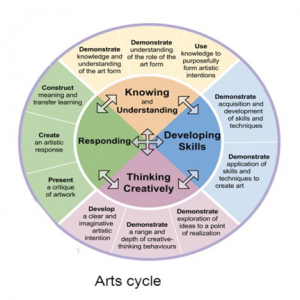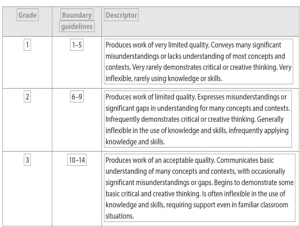
I have been teaching the International Baccalaureate (IB) for ten years. In that time I have found it both frustrating and brilliant to teach. However, I have come to realize that the IB Middle Years Program (MYP) is missing content and skill development for most subjects. The reason may be because the IB is not a skill and knowledge-based content curriculum.
The academic structure of the IB MYP
The structure of the IB is designed based on an individual course guide written by the IB. This course guide is expected to marry with the country or state standards set by the international school. Although some schools will make their own adaptation of a curriculum to marry with the IB curriculum. The IB itself is not a content or skill curriculum, it is a philosophy of learning. The problem is that some schools don’t have a strong curriculum in place for all the subjects before adopting the IB. The MYP classes are graded on a bell curve which makes it difficult for some students to understand where they are academically. A bell curve is when a student is graded relative to other students in the class. Some schools use MAP testing (a measure of academic progress); a form of online standardized testing which helps to understand where students compare globally.
Mapping the 5-year MYP course
Most schools depend on the expertise of the teacher or department to design the curriculum. The only constant for some teachers to base the content or skill expectation is the IB e-assessment. This is an externally assessed project or online test taken in year five (for fifteen to sixteen-year-olds). Teachers utilize this e-assessment to work back from in a backward design approach, whereby goals are set for learning at each grade level. These goals can include identifying the results desired (big ideas and skills), determining levels of evidence that may be needed per grade level, and designing activities that would help students achieve the desired results. The great thing about this is that it gives teachers an amazing amount of freedom to teach what they want to teach.
In the visual arts, I designed the curriculum for grades six to ten (five year groups). In the fifth year group, I have the external e-assessment. This is graded by the IB and student work is sent off in large portfolios online. From the fifth year e-assessment, I set goals for each year group so students can progress toward the appropriate amount of knowledge and skill to achieve the level expected in year ten. The IB gives a few examples of the quality of skills and areas of knowledge needed to do well in the assessment. I feel there could be more help from the IB to design this curriculum. There are some independent websites that help both art teachers and art students through example. Some of these independent resources are more geared toward the IB Diploma level which is a two-year diploma completed in year eleven and twelve.
Websites such as studentartguide.com or inthinking.net are popular with both teachers and students, as there is more example of past work or teaching content to deliver the curriculum. There is a thirst for more resources for the subjects in the IB MYP. I have experienced this in the arts but it is evident that it is across all subjects. Other websites like teacherspayteachers.com, teachingcommons.com, and TES.com are used by teachers to create curriculum. Some teachers join subject area groups on facebook or google plus to get feedback on their curriculum and delivery.
How individual subjects are assessed
Grading in the MYP is based on a best-fit strategy, which is based on a 1-7 grading scale with grade boundaries of 1-32. Percentages and letter grades are not used. A rubric is below. The IB gives generalized rubrics that teachers design and adapt to their subject. The courses are assessed in four parts. These parts differ depending on the subject, but two parts are always based on knowledge and skill development. Leaving the remaining two parts to change and lead toward producing what is learned and/or creative thinking/problem-solving.


(images courtesy of the IB Principles to Practice guide)
In the visual arts, the two last criteria are thinking creatively and responding. A student who is really talented in the art can actually fail the subject, due to the fact that only a quarter of the course is skills based. A student who struggles to create artwork well can pass. This is based on the way the IB grading is set up. As it is set up in four parts- a student only has 25% of the grade on making artwork. I think the MYP(grades 6-10) would better prepare the IB diploma students (grades 11 and 12) if it had more skill and content assessment. In other words, if there was more development toward drawing, painting skill, art basic knowledge development and art history. I think students aren’t getting enough art history and are not practicing enough art-making skills. Skills like sculpture, painting, composition, illustration, computer-based design, textiles, print work. Teachers may not teach enough content or skill per grade level which later impacts learning. This may be the case depending on the school and the resources allocated to the school. Some schools may make time for teachers to discuss and develop learning goals and progress charts across grades.
Time needed to design the curriculum
It is expected by the IB that teachers will design different content options in the same project for one class. For example, four different art movements – Art Deco, Art Nouveau, Russian Constructivism, and Russian minimalism – could be compacted into one unit with a guiding line of inquiry. To further this time constraint, teachers who teach across all grade levels will not have time to create this curriculum specific to the grade-level, since Visual Arts and Music are often understaffed departments. Some teachers may even teach five or more different classes and be asked to design multiple complex units that pull them away from skill practice or deep content is driven inquiry and learning.
Student response
I believe grades are sometimes inflated by teachers who are not permitted to give a zero grade to students, and this is challenging for students to be self-reflective learners. Some students gain a false sense of accomplishment when grades are inflated. Students learn to challenge the grading system because they learn pretty quickly that the grade is based on the teacherʼs judgment. However motivated students are better able to take charge of their learning and practice skills that make them more reflective and potentially better problem solvers. However, this is very much up to the ecosystem of learning and very much depends on the student, the teacher, the administration, the financial resources, and the support and understanding of the parents.
In a time when we are talking about moving away from the traditional content-based curriculum, we must be careful we don’t remove skill and content learning too much from the IB middle years and then reintroduce content memory learning in the IB Diploma years.


